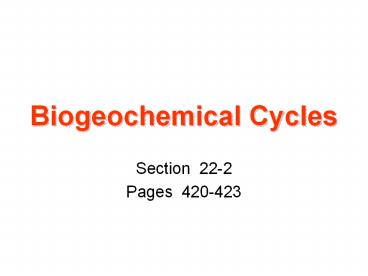Biogeochemical Cycles PowerPoint PPT Presentation
Title: Biogeochemical Cycles
1
Biogeochemical Cycles
- Section 22-2
- Pages 420-423
2
Biogeochemical Cycles
- describe the flow of essential elements from the
environment through living organisms and back
into the environment.
3
Hydrological Cycle
4
Hydrological Cycle(water cycle)
- 1. Reservoir oceans, air (as water vapor),
groundwater, lakes and glaciers evaporation,
wind and precipitation (rain) move water from
oceans to land - 2. Assimilation plants absorb water from the
ground, animals drink water or eat other
organisms which are composed mostly of water - 3. Release plants transpire, animals breathe
and expel liquid wastes
5
Hydrological Cycle
- 1. Reservoir oceans, air (as water vapor),
groundwater, lakes and glaciers evaporation,
wind and precipitation (rain) move water from
oceans to land. - 2. Assimilation plants absorb water from the
ground, animals drink water or eat other
organisms which are composed mostly of water. - 3. Release plants transpire, animals breathe
and expel liquid wastes.
6
Carbon Cycle
7
Carbon Cycle(carbon is required for building
organic compounds)
- 1. Reservoir atmosphere (as CO2), fossil fuels
(oil, coal), durable organic materials (for
example cellulose). - 2. Assimilation plants use CO2 in
photosynthesis animals consume plants. - 3. Release plants and animals release CO2
through respiration and decomposition CO2 is
released as wood and fossil fuels are burned.
8
(No Transcript)
9
Carbon Cycle
- 1. Reservoir atmosphere (as CO2), fossil fuels
(oil, coal), durable organic materials (for
example cellulose). - 2. Assimilation plants use CO2 in
photosynthesis animals consume plants. - 3. Release plants and animals release CO2
through respiration and decomposition CO2 is
released as wood and fossil fuels are burned.
10
Nitrogen Cycle
11
Nitrogen Cycle(Nitrogen is required for the
manufacture of amino acids and nucleic acids)
- 1. Reservoir atmosphere (as N2) soil (as NH4
or ammonium, NH3 or ammonia, N02- or nitrite,
N03- or nitrate
12
Nitrogen Cycle
- 2. Assimilation plants absorb nitrogen as
either NH4 or as N03-, animals obtain nitrogen
by eating plants and other animals. The stages in
the assimilation of nitrogen are as follows - Nitrogen Fixation N2 to NH4 by
nitrogen-fixing bacteria (prokaryotes in the soil
and root nodules), N2 to N03- by lightning and
UV radiation. - Nitrification NH4 to N02- and N02- to N03- by
various nitrifying bacteria.
13
Nitrogen Cycle
- 3. Release Denitrifying bacteria convert N03-
back to N2 (denitrification) detrivorous
bacteria convert organic compounds back to NH4
(ammonification) animals excrete NH4 (or NH3)
urea, or uric acid.
14
Nitrogen Cycle
- 1. Reservoir atmosphere (as N2) soil (as NH4
or ammonium, NH3 or ammonia, N02- or nitrite,
N03- or nitrate - 2. Assimilation plants absorb nitrogen as
either NH4 or as N03-, animals obtain nitrogen
by eating plants and other animals. - 3. Release Denitrifying bacteria convert N03-
back to N2 detrivorous bacteria convert organic
compounds back to NH4 animals excrete NH4,
urea, or uric acid.
15
Phosphorus Cycle
16
Phosphorus Cycle(Phosphorus is required for the
manufactureof ATP and all nucleic acids)
- 1. Reservoir erosion transfers phosphorus to
water and soil sediments and rocks that
accumulate on ocean floors return to the surface
as a result of uplifting by geological processes - 2. Assimilation plants absorb inorganic PO43-
(phosphate) from soils animals obtain organic
phosphorus when they plants and other animals - 3. Release plants and animals release
phosphorus when they decompose animals excrete
phosphorus in their waste products
17
Phosphorus Cycle
- Reservoir erosion transfers phosphorus to water
and soil sediments and rocks that accumulate on
ocean floors return to the surface as a result of
uplifting by geological processes - Assimilation plants absorb inorganic PO43-
(phosphate) from soils animals obtain organic
phosphorus when they plants and other animals - Release plants and animals release phosphorus
when they decompose animals excrete phosphorus
in their waste products
18
- Biogeochemical cycles of other minerals, such as
calcium and magnesium, are similar to the
phosphorus cycle.

